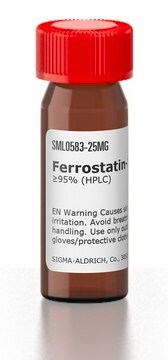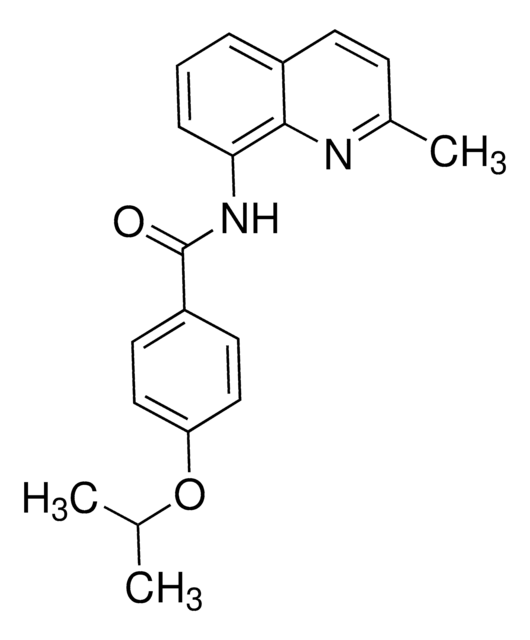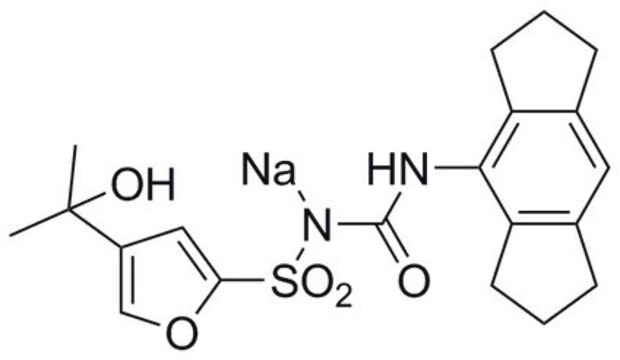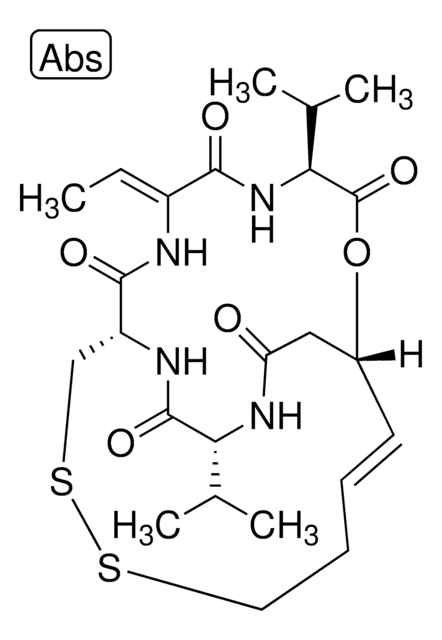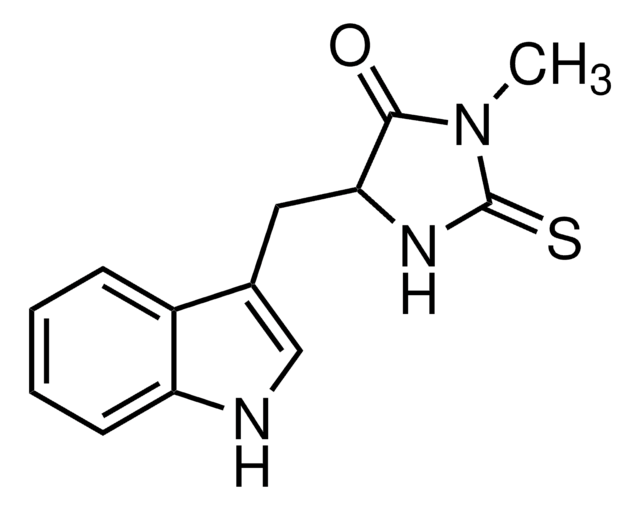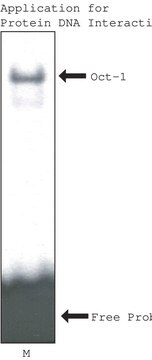SML2100
RIPA-56
≥98% (HPLC)
Synonym(e):
N-Benzyl-N-hydroxy-2,2-dimethylbutanamide, RIPA56
Anmeldenzur Ansicht organisationsspezifischer und vertraglich vereinbarter Preise
Alle Fotos(1)
About This Item
Empirische Formel (Hill-System):
C13H19NO2
CAS-Nummer:
Molekulargewicht:
221.30
UNSPSC-Code:
12352200
NACRES:
NA.77
Empfohlene Produkte
Assay
≥98% (HPLC)
Form
powder
Farbe
white to beige
Löslichkeit
DMSO: 2 mg/mL, clear
Lagertemp.
2-8°C
Biochem./physiol. Wirkung
RIPA-56 is a metabolically stable type III kinase inhibitor that targets receptor-interacting protein 1 kinase (RIP1; RIPK1) in a highly potent and selective manner (RIP1 IC50 = 13 nM) by locking RIP1 in its inactive form, exhibiting no inhibitory potency toward RIP3, IDO or a panel of multiple kinases (tested at 10, 200, and 5 μM, respectively). RIPA-56 protects against TNFα-induced necroptosis (necrosis) upon apoptosis/NF-κB pathway blockage (EC50 = 27 nM/murine L929 and 28 nM/human HT-29 cells) in cultures as well as TNFα-induced mortality and multiorgan damage in a murine model of systemic inflammatory response syndrome (SIRS) in vivo (100% survival rate with 3 mg/kg/12 h or single 6 mg/kg i.p.) with good pharmacokinetics and bioavailability (F post 10 mg/kg p.o. or i.p. dosing = 22% and 100%, respectively, of 2 mg/kg i.v.). Long-term daily RIPA-56 supplementation (150 or 300 mg/kg in chow) is reported to prevent aging-associated deterioration of the male reproductive system in mice.
Lagerklassenschlüssel
11 - Combustible Solids
WGK
WGK 3
Flammpunkt (°F)
Not applicable
Flammpunkt (°C)
Not applicable
Analysenzertifikate (COA)
Suchen Sie nach Analysenzertifikate (COA), indem Sie die Lot-/Chargennummer des Produkts eingeben. Lot- und Chargennummern sind auf dem Produktetikett hinter den Wörtern ‘Lot’ oder ‘Batch’ (Lot oder Charge) zu finden.
Besitzen Sie dieses Produkt bereits?
In der Dokumentenbibliothek finden Sie die Dokumentation zu den Produkten, die Sie kürzlich erworben haben.
Kunden haben sich ebenfalls angesehen
Bo Yan et al.
Chemical communications (Cambridge, England), 53(26), 3637-3640 (2017-03-08)
We report the development of novel Mixed Lineage Kinase Domain-Like protein (MLKL) inhibitors with single nanomolar potency (compound 15 is also named as TC13172). Using the converting biochemistry to chemistry activity-based protein profiling (BTC-ABPP) method, we were able to determine
Yan Ren et al.
Journal of medicinal chemistry, 60(3), 972-986 (2016-12-20)
On the basis of its essential role in driving inflammation and disease pathology, cell necrosis has gradually been verified as a promising therapeutic target for treating atherosclerosis, systemic inflammatory response syndrome (SIRS), and ischemia injury, among other diseases. Most necrosis
Dianrong Li et al.
eLife, 6 (2017-08-16)
A pair of kinases, RIPK1 and RIPK3, as well as the RIPK3 substrate MLKL cause a form of programmed necrotic cell death in mammals termed necroptosis. We report here that male reproductive organs of both Ripk3- and Mlkl-knockout mice retain
Unser Team von Wissenschaftlern verfügt über Erfahrung in allen Forschungsbereichen einschließlich Life Science, Materialwissenschaften, chemischer Synthese, Chromatographie, Analytik und vielen mehr..
Setzen Sie sich mit dem technischen Dienst in Verbindung.

